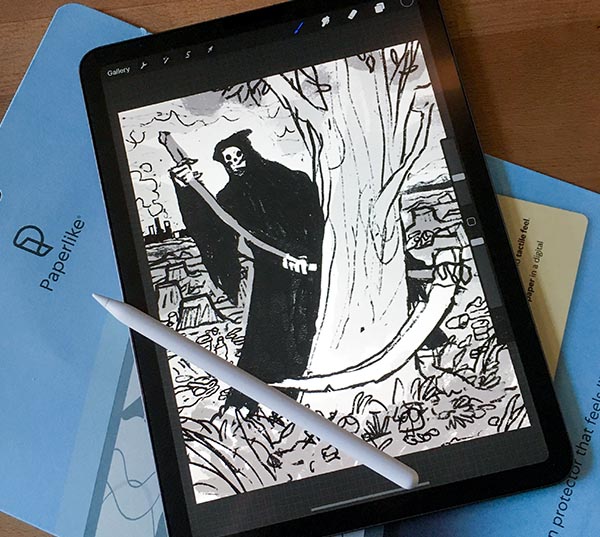Drawing on an iPad

Lately I've been creating many of my drawings using an iPad with Apple Pencil and it's been a mostly enjoyable experience. The choice of quality software out there is great—Procreate, Fresco, Pixaki, PixelStudio, etc.—and the portability afforded by these devices have turned my sketchbooks dusty with neglect. However, every time I get to drawing on my iPad, two issues tend to interrupt my "creative flow" and put me into an eensy teensy state of micro-rage:
- Drawing on glass feels weird
- There is no pen/stylus hover state
Considering the state of the World, these two issues are pretty minor things to complain about. Like I said, it's been a mostly enjoyable experience drawing on the iPad. But usability is usability and tiny speed bumps all over the place can drive a driver mad.
Drawing on glass :vacuum-emojis:
Drawing on a glassy (sometimes greasy) surface is not something I particularly enjoy and doubt others do too. I like the scritch-scratch feeling of drawing on good old paper. Compared to glass, making marks on a textured surface provides me with some form of tactile feedback; that extra bit of texture and friction makes me feel in control of my pencil, and using pressure when drawing feels more natural too. The tablet devices I've used over the years (Wacom Intuos and Cintiq) have always had some form of a slightly textured surface. It's always just been there and I guess I've always taken it for granted, up until the Era of the Glass'ed Smartphone.
To address this slippery glass feeling, I decided to order a Paperlike screen protector. There are alternatives to Paperlike, like Moko and Elecom, and it sounds like they mostly accomplish the same goal though I haven't tried them. But long story short: drawing on an iPad with one of these "textured" screen protectors just feels better. That little bit of grip and toothiness on the surface helps me physically connect with the marks I'm making, similar to using a pencil, pen, or marker on paper. Drawing feels much more natural without that glassy feeling, and there are less interruptions when I'm in the "creative zone." Nice!
The initial textured quality of the surface is great, but after a couple days use can feel like it disappears somewhat due to oil and dirt build up from my fingers. This can be easily fixed with some dish soap and a damp cloth, and like chasing a high, the restored texture is not quite the same compared to the using it for the first time. Still: the difference in feeling between drawing on my slightly dirty Paperlike surface and on a regular iPad screen is pretty obvious.
Overall, if you plan on using an iPad or similar smooth glassy surfaced device to create digital artworks, I highly recommend using some sort of matte/textured screen protector. I bet even the shittiest one will be an improvement over drawing on glass.
No Hover
My second gripe when drawing on an iPad: no pen hovering!
The nice thing about the more traditional mouse in a desktop environment is that you can see where your cursor is before you click. Such a simple concept! Wacom tablets provide this same functionality with their pen tablets: you can hover your pen just above the device's surface and it will be detected, allowing you to move the cursor without actually drawing. Sadly, the Apple Pencil does not provide this, and only detects pen input when the Pencil is touching the surface.
Detecting pen hovering is especially handy when drawing or painting in an application like Photoshop. Imagine your digital brush is set to some arbitrarily large size, Photoshop will replace the cursor with an outline of your brush's footprint. This lets you know how big a mark will be made before you begin drawing. It's sort of like painting in the real world: whether you are holding a tiny brush or a giant stump dipped in paint, you know roughly what size your mark might be. But when your stylus is always the same physical size, how can you prepare for the wide range of different sizes your digital marks can be? Hovering allows app designers to give artists a visual clue about the tools they are about to use.
Because of this lack of hovering there have been many extra undos in my life lately. I need to guess where and how big my brush mark will be when I put my stylus down ... and get it wrong. For loose sketching and speed painting, this is usually not a big issue. But for drawings that require some form of extra precision on my end, I usually end up working on them using a Cintiq+Photoshop instead.
I look forward to the year when Apple allows hovering on the Apple Pencil.